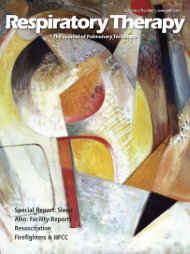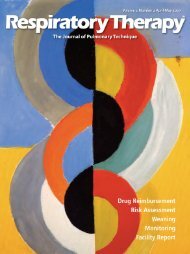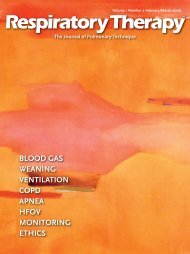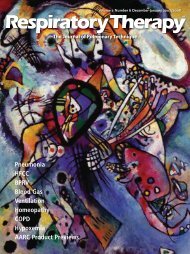RT 02-03 JJ07 main web - Respiratory Therapy Website
RT 02-03 JJ07 main web - Respiratory Therapy Website
RT 02-03 JJ07 main web - Respiratory Therapy Website
You also want an ePaper? Increase the reach of your titles
YUMPU automatically turns print PDFs into web optimized ePapers that Google loves.
of CPAP treatment in 32 patients with moderate OSA 27 as well<br />
as in 16 patients with a mild OSA. 28 Means et al. 29 showed an<br />
improvement on Beck Depression Inventory (BDI) depression<br />
scores after 3 months of treatment in 39 OSA patients, and<br />
Sanchez et al. 30 confirmed lower BDI scores after 1 and 3<br />
months of CPAP therapy in 51 OSA patients. Ramos Platon et<br />
al. 16 underscored the progressive improvement in depression<br />
scores on the MMPI scale over the first year of treatment. A<br />
systematic review on the influence of CPAP on neurobehavioral<br />
performance of patients with OSA also supported the clinical<br />
perspective that typically depressive symptoms remit together<br />
with EDS under CPAP therapy. 31<br />
Among the negative studies on CPAP therapy and its effect on<br />
depression, Borak et al. 32 did not observe any improvement in<br />
emotional status after 3 and 12 months of CPAP therapy in 20<br />
patients with severe OSA, similar to Munoz et al. 33 who also did<br />
not show improvement of BDI scores in 80 subjects with severe<br />
OSA after 12 months of CPAP. Using subtherapeutic CPAP as<br />
the placebo control, Yu et al. 34 and Henke et al. 35 found no<br />
difference in improvement on depression scores between the<br />
treatment and the control group, over a short treatment<br />
duration (1–3 weeks). However, whereas Borak, Munoz and<br />
Henke do not find any effect of CPAP therapy on mood, Yu<br />
observed a positive effect on mood of both CPAP therapy and<br />
the subtherapeutic CPAP control group.<br />
Intriguingly, there are no systematic differences with regards to<br />
the sample size, the initial severity of OSA or the duration of<br />
CPAP therapy which might explain the differences between<br />
studies observing an improvement after CPAP therapy and those<br />
who did not. Several issues have to be considered: First, it is<br />
difficult to design a good control (“placebo”) condition for<br />
CPAP treatment. “Sham-CPAP” which uses insufficient positive<br />
airway pressure as a placebo condition (1 – 2 cm H 20), is now<br />
used more frequently. Two of the negative studies employed this<br />
method for their control group, which raises the possibility that<br />
the previously observed positive effects of CPAP on mood may<br />
have been a placebo effect. Second, compliance to CPAP<br />
treatment is problematic, because patients have to wear a nasal<br />
or even an oranasal device during the entire night. The<br />
compliance may even be particularly decreased in depressed<br />
patients. Indeed, Edinger et al. 36 reported a positive correlation<br />
between lower depression scores on the MMPI prior to<br />
treatment and CPAP compliance at 6 months of treatment in 28<br />
patients. However, Lewis et al. 37 did not find any association<br />
between baseline depression scores and subsequent CPAP use<br />
for the first month of treatment. The most important factor to<br />
explain the differences among these studies may be the<br />
variability in the severity of initial depressive symptoms.<br />
Whereas the severity of OSA itself does not seem to have a<br />
differential impact on mood improvement after CPAP therapy,<br />
the severity of depressive symptoms associated with OSA may<br />
impact response to CPAP treatment. As Millmann indicates,<br />
OSA patients with more severe mood symptoms responded<br />
better to CPAP treatment, whereas patients with less severe or<br />
no mood symptoms actually had less benefit from CPAP<br />
therapy. 12 However, all negative treatment studies either<br />
excluded subjects suffering from a major depressive disorder, or<br />
their depression scores were even at baseline in a normal range<br />
(baseline values: mean BDI of 7.5 in, 32 mean depression score on<br />
POMS scale of 12.5 in, 34 mean BDI of 8 in, 33 and no information<br />
given on assessed GDS scores in 35 ). Future studies should seek<br />
to include OSA patients with a broader range of depressive<br />
symptoms in treatment studies, to investigate whether CPAP<br />
might have a better effect on mood in more depressed OSA<br />
patients.<br />
OSA in depression<br />
Compared to the large number of studies investigating<br />
depressive symptomatology in OSA patients, far fewer studies<br />
have focused on the screening for OSA in a primarily depressed<br />
study population. In one of the few investigations of the<br />
prevalence of OSA in a depressed cohort, Reynolds et al. found,<br />
in a small sample of 17 older patients with major depression,<br />
that 17.6% also had an OSA syndrome, compared to 4.3% of 23<br />
healthy elderly controls. 38 This suggests that OSA might be an<br />
important confounding factor for studies on mood disorders in<br />
general, as its presence is not routinely determined in either<br />
research studies examining mood or clinical settings. However,<br />
many more studies are required to assess the prevalence of OSA<br />
in primarily depressed patients, particularly as it can be<br />
suspected from existing studies that OSA is greatly<br />
underdiagnosed in this patient population.<br />
Clinically, this is of particular concern, as sedative<br />
antidepressants and adjunct treatments for depression may<br />
actually exacerbate OSA. Notably hypnotics prescribed to treat<br />
depression-related insomnia might further decrease the muscle<br />
tone in the already functionally impaired upper airway dilatator<br />
muscles, blunt the arousal response to hypoxia and hypercapnia<br />
as well as increase the arousal threshold for the apneic event,<br />
therefore increasing the number and duration of apneas. 39,40<br />
These effects might differ depending on the patient population<br />
and the severity of OSA. Older depressive subjects are of<br />
primary concern: both, frequency of OSA and depressive<br />
symptoms increase with age, as do prescription and<br />
consumption of sedative psychotropic medication.<br />
Pharmacologic treatment of depression and depression-related<br />
insomnia in this age group should therefore routinely consider<br />
the potential presence of a concomitant OSA.<br />
Finally, as Baran and Richert point out, the diagnosis of a mood<br />
disorder in the presence of OSA has its very own challenges. 41<br />
Considering the DSM-IV definitions, 42 it could either be viewed<br />
as a mood disorder due to a general medical condition, or<br />
classified as an adjustment disorder with depressed mood, due<br />
in particular to EDS and its debilitating consequences on the<br />
patients’ daytime functioning. The identification of<br />
pathophysiological features that allow distinction between OSA<br />
and depression might assist with such diagnostic issues.<br />
Sleep architecture in depression and OSA<br />
Both depression and OSA have been well characterized with<br />
regards to their sleep architecture. Typically, for major<br />
depression, polysomnography (PSG) findings confirm the<br />
patients’ complaints of insomnia, notably difficulties falling<br />
asleep (PSG: increase in sleep latency), frequent awakenings<br />
during the night and early morning awakenings (PSG: idem) as<br />
well as non-refreshing sleep (PSG: decrease in slow wave<br />
sleep). PSG furthermore reveals a shortened REM latency, i.e.<br />
the first episode of REM sleep appears earlier than usual, with<br />
an increase in total percentage of REM sleep during the night, as<br />
well as in its eye movement density (referred to as REM sleep<br />
disinhibition). 43 On the other hand, the sleep of patients with<br />
OSA is fragmented, and contains a lot of transitional sleep<br />
stages (stage 1) at the expense of REM sleep and particularly of<br />
slow wave sleep (stages 3 and 4). 44,45 At least two studies have<br />
58 <strong>Respiratory</strong> <strong>Therapy</strong> Vol. 2 No. 3 � June-July 2007











